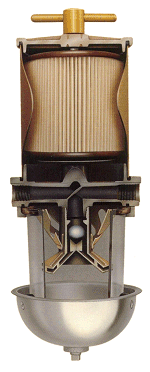Because I’ve been involved with a lot of older boats that have gone from “slow to fast” when repowered, I’ve learned that lots of CRAP can get dislodged from the fuel tank bottoms and walls requiring filtration in “steps.” In other words, filtering from, let’s say, a nominal 30-50 microns (a very fine strainer) to a nominal 10 microns, to a nominal 2-5 micron filter (I consider this to be a “last chance” or final fuel filter,) makes more sense in the applications I’ve been involved in. In a new boat with clean tanks most anything will get you by until a fuel provider pumps some unwanted crap or sludge into YOUR tank. Then your single Racor may not provide you with the filtration needed to protect your investment, and a Multi Stage system will immediately make sense.
As an option to your fuel system, a fuel vacuum gauge will pay for itself quickly when understood by the boat operator. Fuel pressure drop across a filter is a function of fuel flow vs. restriction, and a well designed fuel filter system, which includes all the types of fittings and “stuff” incorporated into the finished system, should start out CLEAN under 3″ of Hg restriction. My field work over the past 20 years has shown that “most” diesels with properly operating lift pumps and fuel systems can tolerate about 10″ of mercury (Hg) restriction before starving for fuel. Always put your vacuum gauge after your “off engine” fuel filters, but before any pumps.
The “micron rating” of fuel filters is a very simple way of allowing someone to select one of the requirements for filtration. From general experience with fuel systems involving the common engines discussed in these forums, I’ve learned that a nominal micron rating is not necessarily the best way of choosing correct filtration. Micron rating should only be used to categorize the media since the ratings were developed based on single-pass efficiency tests using uniform spherical particles as a system contaminant. In real life, diesel fuel contains contaminants of various sizes ranging from sub-micron to 100’s of microns in size.. For a perspective on the size of a micron, 25 microns = .001″ or 50 microns is about the diameter of a human hair.. Tobacco smoke particles run from about .01 to 1 micron in size (that’s gross).
Many filter, engine, and hydraulic equipment companies (including Cummins) do not recognize micron ratings as significant and specifically recommend the use of “Beta ratio” in selecting a filter to meet system requirements. Beta ratio (multi-pass test method) ANSI/B93.31-1973, ISO 4572-1981; this is the only test accepted by ANSI, ISO and NFPA. It is the industry standard for measurement of efficiency. The Beta ratio is determined by counting the number of particles over a given size upstream of the filter and dividing that number by the number of particles over the given size downstream of the filter. Simply put, a nominal 2 micron filter may only capture 94% of 2 micron particles, 98% of particles 10 microns, and close to 100% of particles above 10 microns. A Caterpillar spec filter (one of their most modern “last chance” filters on a very expensive engine (about $100,000.00) – CAT P/N 1R-0749) has these ratings: 100 GPH maximum flow with Beta ratings as follows: 2 microns at 96.5%, 3 microns at 97.8% and 10 microns at 99%. I truly believe that a company like Caterpillar would only use the best filtration technology available to protect their engines, and I would like to see Racor subscribe to a much more widely accepted filtration rating for their filters and not just use name recognition for their marketing hype. I’m not a big Racor fan as many of my past posts will confirm, but I am a believer in using the most modern filtration methods and, more importantly, the most modern filtration media and methods for testing.
Multi-step filtration is the most effective, simplest way to protect modern diesels from the contaminants found in fuel systems. To quote Alaska Diesel, (you know, those Lugger and Northern Light guys,) “Forcing fuel to go through even three separate, progressively finer filters is cheap insurance.”

